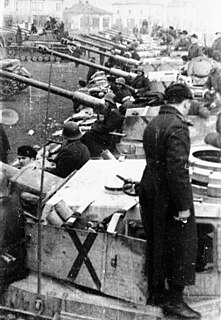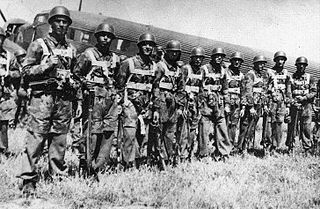 W
WThe Battle of Batina or Batina Operation is one of the battles of the Second World War which took place from 11 to 29 November 1944 at the village of Batina in Baranja, on the right bank of the Danube River, between the units of the Red Army and the People's Liberation Army against the Wehrmacht and their allies. According to some estimates, the Battle of Batina is the biggest battle by the number of participants, the intensity of fighting, and the strategic importance that occurred during the World War II in Yugoslavia.
 W
WThe Belgrade Offensive or the Belgrade Strategic Offensive Operation was a military operation during World War II in Yugoslavia in which Belgrade was liberated from the German Wehrmacht through the joint efforts of the Soviet Red Army, Yugoslav Partisans, and the Bulgarian Army. Soviet forces and local militias launched separate but loosely cooperative operations that undermined German control of Belgrade and ultimately forced a retreat. Martial planning was coordinated evenly among command leaders, and the operation was largely enabled through tactical cooperation between Josip Broz Tito and Joseph Stalin that began in September 1944. These martial provisions allowed Bulgarian forces to engage in operations throughout Yugoslav territory, which furthered tactical success while increasing diplomatic friction.
 W
WThe Bregalnitsa-Strumica operation was an offensive operation of Bulgarian Army during World War II. It was held by Fourth Bulgarian army from 15 October to 14 November 1944 and was aimed to secure the left flank of the First Bulgarian Army, blocking the way for retreat of the German group armies 'E' from Greece.
 W
WThe Operation Draufgänger was a German Wehrmacht military operation against the Yugoslav Partisans at the Montenegrin-Serbian border area, aimed at breaking the Partisan foothold on the Lim river which was a potential penetration point into Serbia. In turn, it was a Partisan counter-operation, known as the Andrijevica Operation. The operation began on 18 July on the Čakor–Gusinje–Andrijevica–Berane line, when Kampfgruppe E burnt down at least 16 villages and killed several hundreds inhabitants. From different directions, German troops attacked villages and a part approached Andrijevica, pushed out parts of two Partisan brigades, and then took over the town on 19 July and continued attacking. The staffs of the Partisan brigades assessed the combined German forces as inadequate and self-initiatively decided to attacks, resulting in great German losses. With the possibility to surround and destroy, the II Assault Corps gave the operational command on 23 July on general attack. From different directions the German troops were surrounded in the wider region of Murino on 24 July. On 28 July the Partisan 2nd, 5th and 17th divisions were ordered to move across the Ibar, which gave the opportunity for the 14th Regiment SS to break through Čakor towards Peć, while larger part of the 21st Division SS broke and many Albanians deserted. The German troops were decisively defeated, and the Partisans moved for action in Serbia. Operation Rübezahl followed.
 W
WKnin Operation was a major Yugoslav Partisan operation during World War II in Yugoslavia launched by the 8th Dalmatian Corps from 7 November to 9 December 1944 with the purpose of destroying German, Ustaše and Chetnik formations in North Dalmatia and the city of Knin, then part of the Independent State of Croatia. It was the final part of the 8th Corps offensive for the liberation of Dalmatia which began on 12 September 1944. The Knin operation had three phases: Initial battles on approaches to Knin from 7 November to 25 November, main battle and liberation of Knin from 26 November to 4 December, and final battles and pursuit of retreating Axis forces to Otrić in Lika from 5 December to 9 December.
 W
WThe Kosovo Operation was a series of military operations leading up to one final push during World War II, launched by the Bulgarian army with the assistance of Albanian and Yugoslav Partisans to expel German forces from Kosovo and prevent the retreat of German forces from Greece. German Army Group E was withdrawing through it from Greece towards Bosnia, since the escape route through Niš and Belgrade had been closed by the Yugoslav Partisan, Bulgarian and Soviet forces.
 W
WOperation Kugelblitz was a major anti-Partisan offensive orchestrated by German forces in December 1943 during World War II in Yugoslavia. The Germans attacked Josip Broz Tito's Partisan forces in the eastern parts of the Independent State of Croatia in an attempt to encircle and destroy them, thereby preventing the Partisans from entering the Territory of the Military Commander in Serbia. Operation Kugelblitz was followed up immediately by Operation Schneesturm (Blizzard) which sought to capitalise on the initial success of Operation Kugelblitz. Both operations are associated with the Sixth Enemy Offensive in Yugoslav historiography.
 W
WNiš operation was an offensive operation of the Bulgarian army, supported by Yugoslav Partisans against German Army Group E in order to secure the left flank of the Third Ukrainian Front of the Red Army.
 W
WOperation Halyard, known in Serbian as Operation Air Bridge, was an Allied airlift operation behind Axis lines during World War II. In July 1944, the Office of Strategic Services (OSS) drew up plans to send a team to the Chetniks force led by General Draža Mihailović in the German-occupied Territory of the Military Commander in Serbia for the purpose of evacuating Allied airmen shot down over that area. This team, known as the Halyard team, was commanded by Lieutenant George Musulin, along with Master Sergeant Michael Rajacich, and Specialist Arthur Jibilian, the radio operator. The team was detailed to the United States Fifteenth Air Force and designated as the 1st Air Crew Rescue Unit. It was the largest rescue operation of American Airmen in history. According to historian Professor Jozo Tomasevich, a report submitted to the OSS showed that 417 Allied airmen who had been downed over occupied Yugoslavia were rescued by Mihailović's Chetniks, and airlifted out by the Fifteenth Air Force. According to Lt. Cmdr. Richard M. Kelly (OSS) grand total of 432 U.S. and 80 Allied personnel were airlifted during the Halyard Mission.
 W
WThe Raid at Ožbalt was an operation on 31 August 1944 in which 105 Allied prisoners of war (POWs) were rescued by Slovene Partisans. The majority were liberated from a work site at the village of Ožbalt about 25 kilometres (16 mi) west of Maribor on the railway line to Dravograd in the German Reichsgau Steiermark (Styria), now part of modern-day northern Slovenia. Six of the liberated POWs were separated from the group during an engagement with the Germans a few days after their liberation, but following a 14-day trek across 250 kilometres (160 mi) they were flown out of a Partisan airfield at Semič to Bari, Italy. The successful escapees consisted of eight Frenchmen, nine New Zealanders, 12 Australians, and 70 British POWs.
 W
WOperation Rösselsprung was a combined airborne and ground assault by the German XV Mountain Corps and collaborationist forces on the Supreme Headquarters of the Yugoslav Partisans located in the Bosnian town of Drvar in the Independent State of Croatia during World War II. The operation was launched on 25 May 1944, and was aimed at capturing or killing the Partisan leader Marshal Josip Broz Tito and destroying the headquarters, support facilities and co-located Allied military missions. It is associated with the Seventh Enemy Offensive in Yugoslav history, forming part of the Seven Enemy Offensives historiographical framework. The airborne assault itself is also known as the Raid on Drvar.
 W
WThe Stratsin-Kumanovo operation was an offensive operation of the Bulgarian Army in occupied Yugoslavia during the participation of Bulgaria in World War II against the Third Reich, which led to the capture of Skopje in 1944.
 W
WThe Syrmian Front was an Axis line of defense during World War II. It was established as part of the Eastern Front in late October 1944 in Syrmia and east Slavonia, northwest of Belgrade.